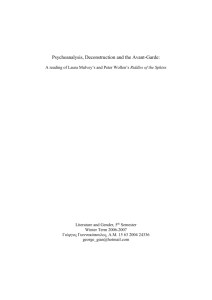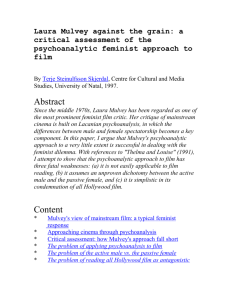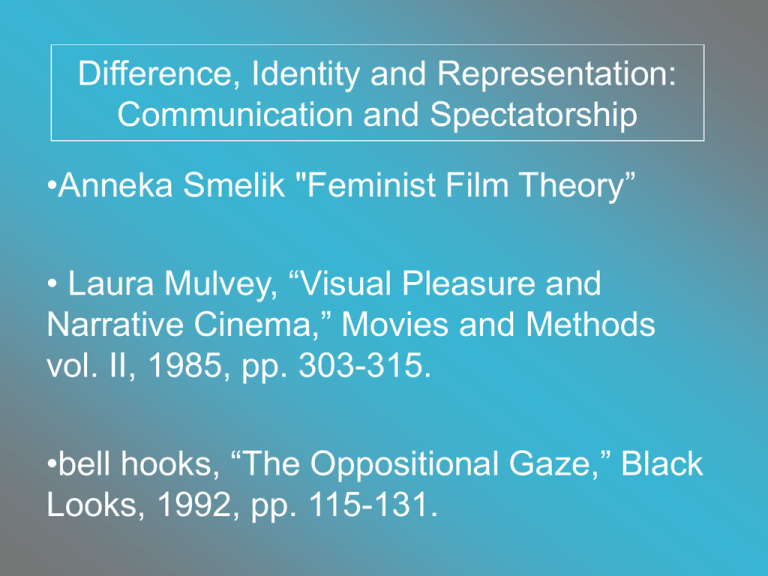
Difference, Identity and Representation:
Communication and Spectatorship
•Anneka Smelik "Feminist Film Theory”
• Laura Mulvey, “Visual Pleasure and
Narrative Cinema,” Movies and Methods
vol. II, 1985, pp. 303-315.
•bell hooks, “The Oppositional Gaze,” Black
Looks, 1992, pp. 115-131.
Gender and Media
• What do we mean by gender?
• Do films construct or reflect gender?
Early Feminist Critiques
• Early criticism focused on stereotypes of
women and their negative impact on
female spectators
• Advocated for corrective positive images
of women.
Structural Theory and Psychoanalysis
• The early 1970s Claire Johnston was one of the first
to draw on semiotics and Lacanian psychoanalysis
suggesting:
• Cinema provides a male myth of “woman”
• Woman in classical cinema serve as an “empty sign”
exchanged by men; the object rather than the subject
of desire.
Johnston was critical of Hollywood cinema, but also saw
it as an important site for study and intervention.
She called for an alternative narrative cinema.
Structural Theory and Psychoanalysis
Together these two frameworks provide film theorists
with ways for thinking about how the viewer as a
subject participates in the meaning of the film.
• Semiotics--theory of signs. A tool for analyzing how
meaning is produced through language and ideology.
• Psychoanalytic theory. A theory of the subject as
constituted through sexual difference.
Laura Mulvey
•
•
•
•
•
•
Film Theorist, Media Scholar, Filmmaker
Great Britain (1941 - )
Feminist Film Studies
"Visual Pleasure and Narrative Cinema” - 1975
Psychoanalysis, Semiotics
Sustained dialog on how sexual difference is reproduced in the
act of watching classical cinema - 30s, 40s, 50s…
• Fascination of cinema
• She argues women have been placed in a specific,
powerless position in cinema.
• How does the cinematic system actively, and
passively, make this so?
Rear Window (1954), Alfred Hitchcock
Mulvey’s key example:
Alfred Hitchcock
• Vertigo, Alfred Hitchcock, 1958
• Alfred Hitchcock - 1899-1980, The “Master of
Suspense”, Rear Window (1954), and Psycho
(1960)
•
•
•
•
Representation of women as an aspect of visual pleasure
Cinema reproduces gendered subjects
Men = active | Women= passive
You are positioned as spectator when you identify with the
characters
• Positioning of camera, lightning, the roles, all decisions set up
positions: you thought about yourself as the one looking and not
being looked at.
• Psychoanalytic theory as it is related to film culture; this is not
about psychoanalyzing characters, but mechanisms of viewing,
this is, spectatorship.
– More than the act of looking, the gaze is a viewing relationship,
characteristic of a particular set of social circumstances
• Even if it was wrong, it influenced a body of work that was very
influential
• Hypothesis: psychoanalysis + semiotics = understanding film
• Analysis does not have to always be tied up to economy or class
Vetigo
QuickTime™ and a
decompressor
are needed to see this picture.
Jimmy Stewart as Jeffries in Rear Window
• Psychoanalysis - Freud
• Conscious / Pre-Conscious / Unconscious
Repression
• Id / Ego / Superego
Interrelation of Individual/Society/Biology
• Talking Cure: Bring into the consciousness what
is making the patient suffer
Sigmund Freud
•Model of Psychosexual development
Individual - Civilization
•Libido: develops by changing its object:
Sublimation
Stages - Oedipus complex
• Key theoretical figures she is in dialogue with
Louis Althusser - Sigmund Freud - Jacques Lacan
• The State apparatus as a set of cultural institutions
• Althusser: the “ideal spectator,”; the text and
interpellation; it demands a particular type of
spectator.
• There is no true subject: you are always product of
social relations - there is always the possibility of
psychosis.
Louis Althusser
• Feminist theorists present Freud’s model of the unconscious
and sexuality as accurate description of the place of women in
the phallogocentric culture--not as a necessary or natural
condition, but one specific to contemporary society.
• The unconscious shapes cinematic practices
• Male pleasure, dominant pleasure
• Male ambivalence toward the female figure: leads toward
extreme positions - to devalue, punish, save her, or to make a
pedestal figure, a fetish out of her.
• The conflict is resolved through one of two ways:
Sadistic narrative: woman must be
punished (usually death or marriage)
Fetishism: woman serves as
polished phallic object (denial) — the
ideal of perfect beauty.
Female: lure and a threat of
castration - she lacks a penis Lacan
Lacan: mirror stage
Formative of the “I”
Permanent structure of subjectivity
Paradigm of the imaginary order
Dual relationship
Body - Ego
Imaginary - Real
Fragmentation - Wholeness
IDENTIFICATION with the image
Jacques Lacan
Entering into the symbolic:
language
Real / Symbolic / Imaginary
• In cinema, the spectator is made to identify with the male look
because the camera films from the optical, as well as libidinal,
pint of view of the male character.
“Three Looks”
The characters in the film look at each other
The viewer looks at the screen
The camera looks at the event being filmed.
• Mulvey aims to disrupt pleasure
• Analysis / New Cinema
Hitchcock--as voyeur
QuickTime™ and a
decompressor
are needed to see this picture.
Grace Kelly as Lisa
• Pleasure functions in two ways:
• Scopophilia: pleasure in looking at objects (voyeuristic gaze)
• Narcissism: identification with on screen (male) protagonist as
a controlling figure.
• Within the patriarchal order, women are the “other”: the empty
object through which identity is constructed. This becomes
problematic for women’s identity.
• This is where the idea of the women becoming an object in the
film arises.
A Feminist Counter-Cinema
Mulvey advocates for an alternative Cinema. One that
doesn’t adhere to narrative representational
conventions.
• Feminist filmmaking - must deconstruct and destroy the
gaze
• Destroy the satisfaction, pleasure and privilege.
• Employs techniques of distanciation (limiting
identification).
Why not just have active female protagonists? (The gaze
is masculine within patriarchal logic.)
A Feminist Counter-Cinema
Why not just have active female protagonists?
• The gaze is not essentially male, 'but to own
and activate the gaze, given our language and
the structure of the unconscious, is to be in
the "masculine" position'
• The gaze is masculine within the terms of
patriarchal culture.
• Challenges and critiques
• Is her argument complicit with normative heterosexual order?
• Other forms of spectatorship?
• How can she deny forms of female spectatorial pleasure in
cinema?
• Do men see women as representing their castrated selves?
What other psychoanalytic models are available?
• Does the emphasis on psychoanalysis overemphasize the
binary of gender? How do we reconcile other forms of identity
and difference?
Films with women protagonists
Mary Anne Doane and others began to consider the
female spectator in relation to “the Woman’s Film”
(during the 1940s there were many films that
featured female protagonists targeting female
audiences).
• A Letter to Three Wives, Joseph Mankiewicz, 1949
• Gentleman Prefer Blondes, Howard Hawks, 1953
bell hooks
• Theorist, activists, feminist
• Substance of the books, not the “I” (1952 - )
• “Ain’t I a Woman?: Black Women and Feminism” - 1981
•
•
•
•
•
•
“The Oppositional Gaze”
Political dimension of the “Gaze”
Power: Stuart Hall - Hegemony
Agency: awareness / looking to resist
Television - negation of Black representation
Manthia Diawara: “Rupture”
Critical Discussion
Lena Horne
Manthia Diawara
•
•
•
•
Looking “too deep” hurt - Black women and cinema
Mulvey: “woman as image, man as bearer of the look”
Mainstream feminist film criticism ignores Black women
“Women”: effaces differences in specific socio-historical
contexts
1986
• “Connection between the realm of representation in
mass media and the capacity of black women to
construct ourselves as subjects in daily life” (p. 127)
• Is there a black female gaze? Essentialist notion
• Trinh T. Minh-ha: “subjectivity does not merely
consist in talking about oneself… be this talking
indulgent or critical”
• Not offering diverse representations, but imagining
transgressive possibilities for the formulation of
identity
Trinh T. Minh-ha
Sankofa
Passion of Remembrance
1986
Recent Feminist Film Theory
•
•
•
•
•
Female spectatorship and masquerade
Gender as performed
Gender is problematic / wonderful / complex
Oppositional Viewing
Psychoanalytic theory becomes less monolithic as
discussions move beyond the binary of masculine/feminine
gender and address other aspects of identity (race, age,
ability, etc)
After the 1980s: an increase in films by women directors and with
complex representations of gender and sexuality
• An Angel at My Table, Jane Campion, 1989
• Things You Can Tell by Just Looking at Her, Rodrigo Garcia,
2000


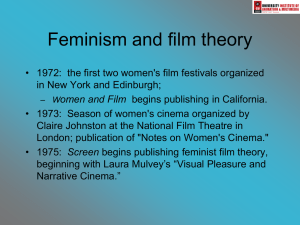




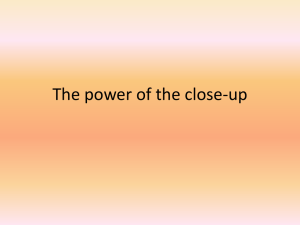
![[Lecture 4] from attractions to narrative integration 2012 for wiki](http://s2.studylib.net/store/data/005411128_1-612acd924ade64473e514356e531fdfd-300x300.png)

![Mulvey, Laura. 1997. "Visual pleasure and narrative cinema [1975]."](http://s3.studylib.net/store/data/007529433_2-3b37ade34c5426b5e82121d5b330aac5-300x300.png)
